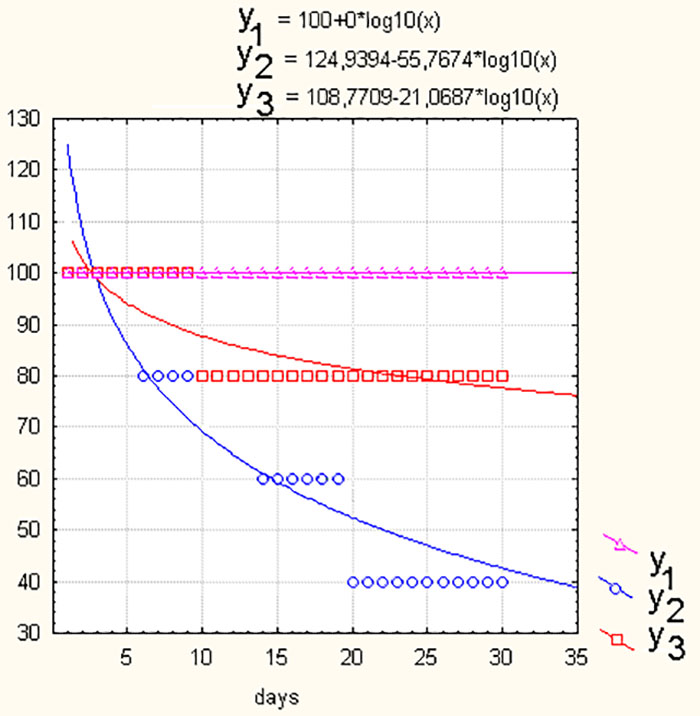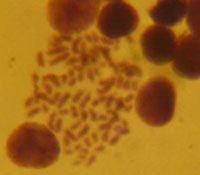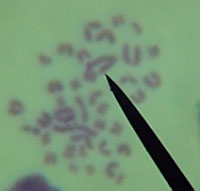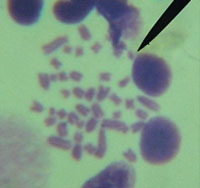- Home
- About the Journal
- Peer Review
- Editorial Board
- For Authors
- Reviewer Recognition
- Archive
- Contact
- Impressum
- EWG e.V.
Cite as: Archiv EuroMedica. 2022. 12; 3: e1. DOI 10.35630/2199-885X/2022/12/3.7
One of the most urgent problems of modern radiobiology is the search and development of new effective radioprotectors. Radiation damage causes physiological disturbances and profound changes in hematological indicators. The severity of such changes and the speed of development of disturbances are dose-dependent. Radioprotectors differ by their effectiveness and duration of their protective action. They should be non-toxic, effective, not cause pronounced adverse reactions, act relatively quickly and for a long time. In this regard, copper coordination compounds are of particular interest.
The main biogenic role of copper is to participate in the processes of hematopoiesis. It is involved in the neutralization of the toxins of microorganisms, as well as prolongs the action of antibacterial medications, and reduces inflammatory reactions. Copper complexes have low toxicity and pronounced radioprotective properties.
The aim of the study is to identify the possible radioprotective effects of the bis[bis(3,5-dimethylpyrazol-1-yl)acetato]copper(II) complex, based on cytogenetic analysis. As a result of cytogenetic studies, it was found that Cu[HC(COO)(pzMe2)2]2 has the ability to prevent or weaken the effect of ionizing radiation. The findings were also confirmed by survival assessments (80%).
It can be concluded that this compound promotes reparative processes in the bone marrow cells of irradiated animals.
Keywords: radiation, copper(II) complexes, proliferative activity, chromosome aberrations, cell ploidy
Irradiation in relatively high doses causes a complex of pathological functional and morphological changes in the internal organs and systems of the body. Radiation damage also causes profound changes in hematological indicators. In particular, according to the literature data, the count of leukocytes, platelets, and red blood cells (RBC) in blood may temporarily decrease in phase I in case of irradiation of large areas of the body [1-5].
Damage to different structures, including hematopoietic organs, is characteristic for the exposure to high doses of radiation. The severity of such changes and the rate of the development of disturbances depend on the quantitative parameters of exposure (dose).
In the peripheral blood, by the days 2-4, the leukocyte count decreases due to a decrease in the number of neutrophils. The lymphocytopenia persists and somewhat progresses. Additionally, thrombocytopenia and reticulocytopenia occur by the days 8-15. RBC count, however, does not decrease significantly. By the end of phase II, a slowdown in blood clotting is detected. The myelogram shows a decrease in the number of both immature and mature cells. Moreover, the count of the latter decreases in proportion to the time elapsed after irradiation. By the end of phase II, only mature neutrophils are found in the bone marrow. The results of biochemical blood tests indicate a slight decrease in the albumin fraction of serum proteins, normalization of blood sugar levels and serum bilirubin.
Predominant characteristic in the III phase of the disease is the severe damage to the blood system. Along with this, immune suppression, hemorrhagic syndrome, development of infections and autointoxication take place. The leading role in the development of infection-related complications is played by autoinfection, which acquires pathogenic significance against the background of a pronounced inhibition of hematopoiesis and suppression of the immunobiological reactivity of the organism. Therefore, one of the most urgent problems of modern radiobiology is the search for new effective radioprotectors. Radioprotectors are differentiated by their effectiveness and duration of the protective action. According to Saxonov et al. [6], the requirements for radioprotectors are as follows: the compound must be sufficiently effective and not cause any severe adverse reactions; should act quickly and for a relatively long time; must be non-toxic and have a therapeutic coefficient of at least 3; should not have even a short-term negative effect on the body; should have a dosage form convenient for oral administration or injection; should not reduce the body's resistance to other unfavorable environmental factors; must be stable during storage, as well as retain its protective and pharmacological properties for at least 3 years.
The main biogenic role of copper is its participation in the processes of hematopoiesis [7]. This microelement is involved in the synthesis of hemoglobin, which is responsible for oxygen transport in the body, as well as in increasing the rate of blood circulation. Copper is actively involved in the metabolism of carbohydrates: it activates the oxidation of glucose and slows down the cleavage of glycogen in the liver. Copper is also important for the immune system. It is involved in neutralization of toxins of microorganisms, as well as prolongs the action of antibacterial medications [8,9], and reduces inflammatory reactions. According to our early studies [10,11], copper-based complexes have low toxicity and pronounced radioprotective properties.
The aim of the study was to identify a possible positive effect of the copper complex Cu[HC(COO)(pzMe2)2]2 on burns and its radioprotective effects. The copper(II) complex Cu[HC(COO)(pzMe2)2]2 has been chosen because it has a number of advantages: it is inexpensive, stable, easy to use, has low toxicity and a prolonged action. We made an attempt to compare its therapeutic effect in case of thermal burns and radiation, with its chemical and physical properties.
The analytically pure copper(II) bis(3,5-dimethylpyrazol-1-yl)acetato complex, Cu[HC(COO)(pzMe2)2]2, was synthesized by a modified literature method [12,13], by a one-step reaction of the sodium salt of bis(3,5-dimethylpyrazol-1-yl)acetic acid [14], Na[HC(COO)(pzMe2)2], with CuCl2.2H2O in water solution (Fig. 1).
![Figure 1. Chemical structure of Cu[HC(COO)(pzMe2)2]2](7-artikel-image1.jpg)
Figure 1. Chemical structure of Cu[HC(COO)(pzMe2)2]2
In order to reveal the possible radioprotective effect of the copper(II) complex Cu[HC(COO)(pzMe2)2]2, a series of in vivo experiments was carried out on white outbred, mature rats with an average weight of 180 g. The animal experiments were performed in accordance with Directive 2010/63/EU.
Animals were divided into 3 groups: I – intact animals (without irradiation), II – with irradiation only, III – irradiation + injection of the copper complex.
An hour before a single irradiation (incorporation) of animals with technetium at a dose of 15.78 mCi, Cu[HC(COO)(pzMe2)2]2 was intraperitoneally injected at a dose of 50 mg/kg in a form of an aqueous suspension (solution with DMSO) with a volume of 2 mL. Irradiated rats that did not receive radioprotective complexes (pure exposure) were taken as a "control group". The radioprotective activity of Cu[HC(COO)(pzMe2)2]2 was evaluated in terms of survival, mean life expectancy, and cytogenetic parameters.
Survival and mean life expectancy of animals were monitored, describing the dynamics of the lethal outcomes in experimental rats during a 30-day period of the experiment (after irradiation with technetium at a dose of 15.78 mCi).
The bone marrow isolated from the femur served as a material for cytogenetic studies. According to the Ford-Wollam method, the mitotic index (MI), chromosomal aberrations (ChA) and polyploid cells (PC) were determined.
Statistical analysis of the obtained data was carried out using a number of computer programs designed for statistical processing of digital data arrays. Along with the programs developed by us, specialized statistical packages Statsoft-7, SPSS-10.0, MedCalc and StatGraphics Plus were used. The analysis was carried out using correlation and regression methods [15,16].
The results (presented on Table 1) regarding the survival and mean life expectancy of rats in 3 groups showed that in the group of rats with the introduced complex (Group III), the indicators are much better (80%) than in animals exposed to irradiation only (Group II) (40%). We obtained similar data (in the case of compound administration) in terms of these indicators in intact animals.
Table 1. Survival and average life expectancy of rats
| Group | Survival in % | Mean life
expectancy in days |
| Intact animals | 100 | 30 |
| Irradiation only | 40 | 20 |
| Irradiation + injection | 80 | 26 |
Survival dynamics curves are described by logarithmic regression curves (the equations are shown in Fig. 2, where x indicates the days of experiments, y1 is the survival in the intact group (Group I), y2 is for the survival in Group II and y3 is for the survival in Group III), with the help of which it is possible to predict the outcome even in more long-term periods, indicating significant beneficial effect of the compound on radiation damage.

Figure 2. Regression curves corresponding to survival in Groups I, II and III.
In order to identify a possible radioprotective effect, the effect of Cu[HC(COO)(pzMe2)2]2 in case of incorporation of the technetium (Tc) isotope with an activity of 15.78 mCi was studied. An hour before the intraperitoneal injection of the isotope in a volume of 2 mL, the rats were also injected intraperitoneally with Cu[HC(COO)(pzMe2)2]2 dissolved in DMSO at a dose of 50 mg/kg in a volume of 2 mL. To compare the effectiveness of the compound, groups II and III were compared (irradiation only vs irradiation + Cu[HC(COO)(pzMe2)2]2). Analysis of the karyotype of both experimental groups revealed statistically significant differences in MI, ChA and PC, when compared with the indicators of the intact group (Table 2). Cytogenetic disorders detected on the 30th day after incorporation of Tc with an activity of 15.78 mCi (polyploid cell, deletion, fragment) are shown in Figure 3.
Table 2. Average values of MI, ChA and PC in groups I, II, III
| Groups Indicators | Intact animals (Group I) | exposure to Тс (Group II) | Тс+compound (Group III) |
| MI%⎪ | 20,35±2,8 | (*) 9,8±0,96 | (*) 13,8±0,44 * |
| ChA% | 2,6±0,26 | (*) 6,8±0,74 | (*) 5,2±0,6 |
| PC% | 0,5±0,08 | (*) 4,6±0,53 | (*) 3,6±0,42 |
(*)
Significant differences between the intact group (Group I) and Groups
II, III
*
Significant differences when comparing Groups II and III
When comparing the cytogenetic indicators of Groups II and III, a significant difference in the proliferation of bone marrow cells (BMC) was found. It was also noted that chromosomal aberrations in the form of fragments and the number of polyploid cells tends to decrease in Group III.
 |
 |
 |
| a) | b) | c) |
Figure 3. Cytogenetic disturbances detected on day 30 after incorporation of Tc (Group II) with activity of 15.78 mCi (polyploid cell (a), deletion (b), fragment (c)).
As a result of studies of cytogenetic parameters, survival and mean life expectancy, it was found that the copper(II) complex Cu[HC(COO)(pzMe2)2]2 has the ability to prevent or mitigate the effects of ionizing radiation on the animal body. Based on the cytogenetic indicators, it can be concluded that this compound promotes reparative processes in the bone marrow cells of irradiated animals.
The work was supported by the Science Committee of RA, in the frame of the research project No 21T-1F126